- Joined
- Feb 2, 2011
- Messages
- 2,093
NEW RELEASES FOR OCTOBER 2022
THE TROJAN WAR
TROY
Laomedon, the legendary King of Troy, son of Ilus and Eurydice and father of Podarces (later famous as King Priam of Troy) brought about his own destruction and that of the initial city of Troy, by not keeping his word.
Laomedon refused to give the gods Apollo and Poseidon a promised reward for building the original walls of Troy. The gods sent a pestilence and a sea monster to ravage the land.
An oracle revealed to Laomedon that the only way to save Troy would be to sacrifice his daughter Hesione. She was bound to a rock to await her death by the sea monster.
The Greek hero Heracles who happened to be at Troy, offered to kill the sea monster and rescue Hesione in exchange for Laomedon’s divine horses, which had been a gift from the god Zeus to Tros, Laomedon’s grandfather.
Once Heracles had killed the monster and saved Hesione, Laomedon refused to give up the horses.
Heracles left Troy and then returned with a band of warriors, captured the city, and killed Laomedon and all his sons except for Priam, and Tithonus.
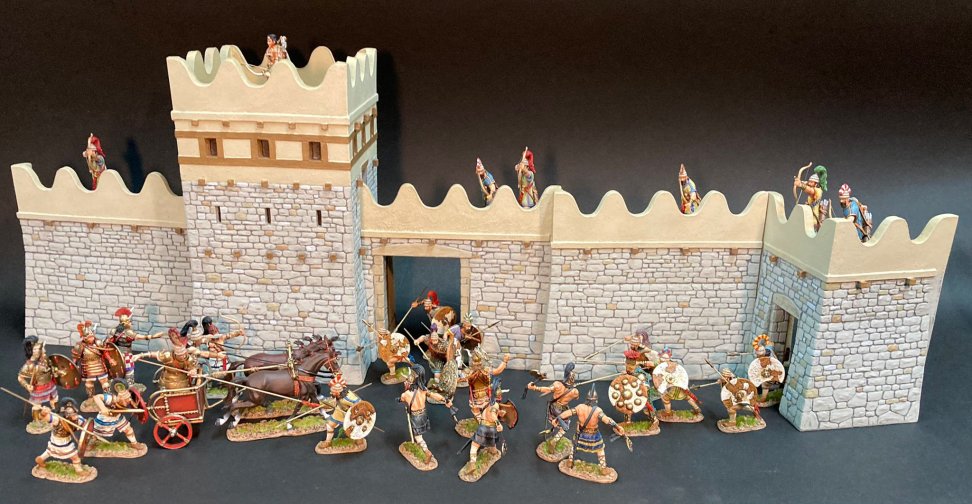
It was Priam who set about rebuilding the walls of Troy. Priam became a natural leader and had a deep understanding of trade and exchange. The location of Troy at the mouth of the Hellespont, the straits through which all sea traffic too and from the east were obliged by geography to pass. This afforded Troy tremendous opportunities for enrichment. The tolls and tariffs meant the city grew in greatness and wealth.
The towers and Priam’s new palace reached higher than the levels of the walls, and gleamed in the sun to tell the world that Troy, the jewel of the Aegean, was the greatest city in the world, ruled over by a mighty king and prospering under the protection of the gods.
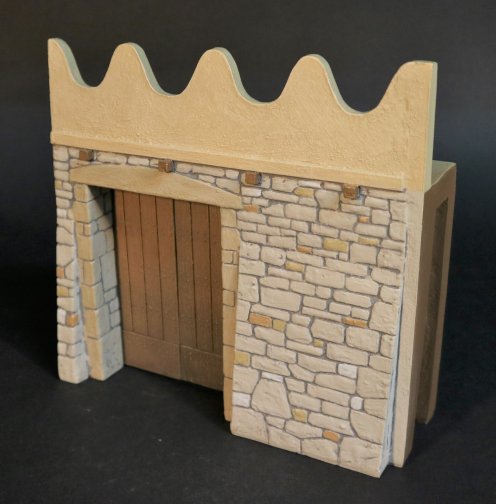
TROY-02
THE TROJAN WAR,
TROY AND HER ALLIES,
THE SCAEAN GATEWAY.
(3 pcs)
model Size 7 ¼ ” x 2 ½ ” x 7 ”
(9 1/2” x 9” x 5” box size 1.32kg weight)
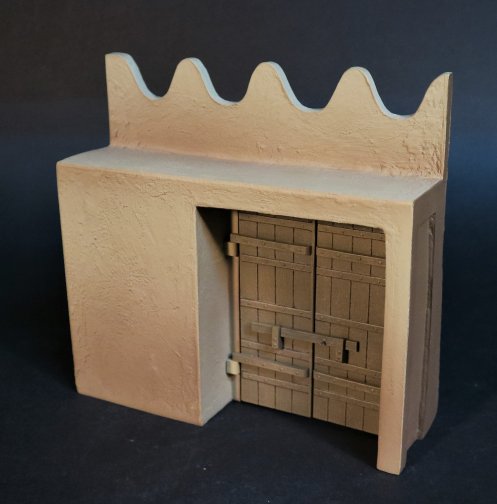
Large towers were usually built into the walls of Troy to defend a major gateway. The South tower was built to guard the Scaean Gate.
The Eastern wall was also reinforced by a large tower. This massive bastion at the north east corner of the city was built to defend a well which was the main water supply.
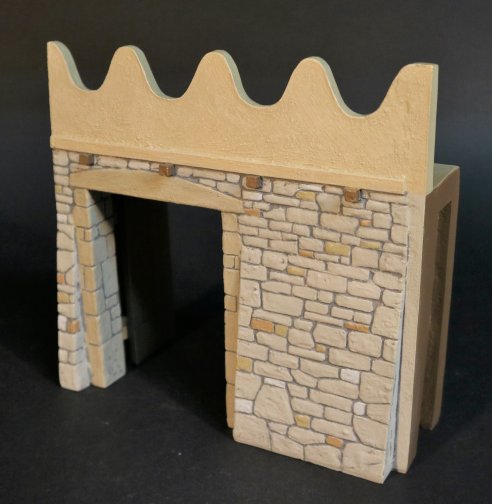
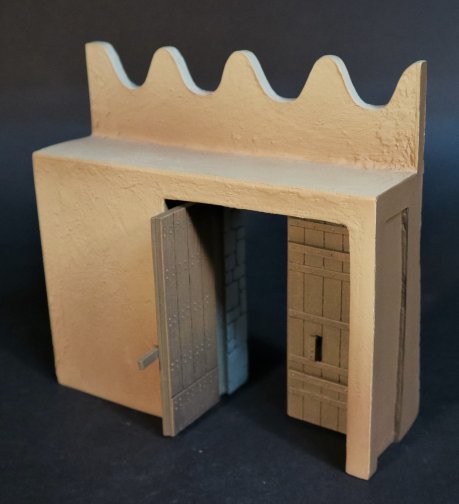
The city walls of Troy will be available over the next 4 months. The total width of all the Troy wall sets together, as seen in the above picture will be 32” and approximately 8” depth.
THE GREEKS
Traditionally, the Trojan War arose from a sequence of events beginning with a quarrel between the goddesses Hera, Athena and Aphrodite. Eris the goddess of discord, was not invited to the wedding of Peleus and Thetis, and so arrived bearing a gift. A golden apple, inscribed “for the fairest”.
Each of the goddesses claimed to be the “fairest”, and the rightful owner of the apple. They submitted the judgement to a shepherd they encountered tending his flock. Each of the goddesses promised the young man a boon in return for his favour. Power, wisdom, or love. The youth, in fact Paris, a Trojan prince who had been raised in the countryside, chose love, and awarded the apple to Aphrodite.
As his reward, Aphrodite caused Helen, the Queen of Sparta, and the most beautiful of all women, to fall in love with Paris.
The judgement of Paris earned him the ire of both Hera and Athena, and when Helen left her husband, Menelaus, the Spartan king, for Paris of Troy, Menelaus called upon all the kings and princes of Greece to wage war upon Troy.
Menelaus’ brother Agamemnon King of Mycenae, led an expedition of Achaean troops to Troy and besieged the city for ten years because of Paris’ insult. After the death of many heroes, including the Achaeans, Achilles, Ajax and the Trojans Hector and Paris, the city fell to the ruse of the Trojan Horse.
The Achaeans slaughtered the Trojans, except for some of the women and children whom they kept or sold as slaves. They desecrated the temples, thus earning the wrath of the gods.
Few of the Achaeans returned safely to their homes, and many founded colonies in distant shores.
The Romans later traced their origin to Aeneas, Aphrodite’s son and one of the Trojans, who was said to have led the surviving Trojans to modern day Italy.
ANTILOCHUS OF PYLOS
Antilochus was the son of king Nestor, and the brother of Thrasymedes.
He accompanied his father and his brother to the Trojan war. He was distinguished for his beauty, swiftness of foot, and skill as a charioteer.
Though he was among the youngest of the Greek princes, he commanded the Pylians in the war and performed many deeds of valour.
He was a favourite of the gods and a friend of Achilles, to whom he was commissioned to announce the death of Patroclus.
When his father Nestor was attacked by Memnon, Antilochus sacrificed himself to save him, thus fulfilling an oracle which had warned to “beware of an Ethiopian”.
Antilochus’ death was avenged by Achilles, who drove the Trojans back to the gates, where he is killed by Paris.
His ashes, along with those of Achilles and Patroclus, were enshrined in a mound on the promontory of Sigeion, where the inhabitants of Ilium offered sacrifice to the dead heroes.
Among the Trojans he killed were Melanippus, Ablerus, Atymnius, Phalces, Echepolos and Thoon. At the funeral games of Patroclus, Antilochus finished second in the chariot race and third in the foot race.
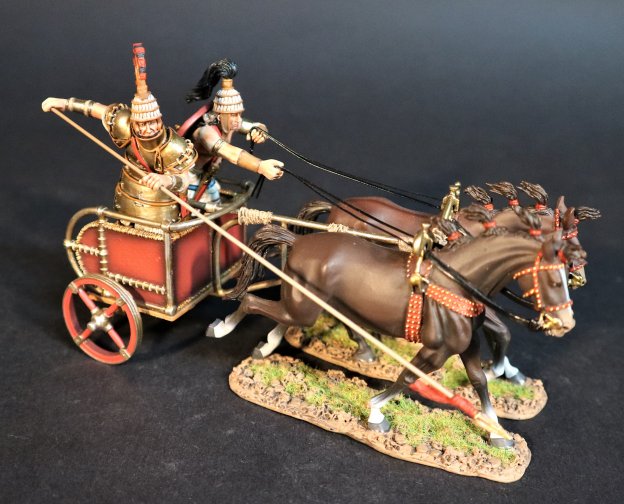
TWG-30
THE TROJAN WAR,
THE GREEKS,
GREEK CHARIOT,
ANTILOCHUS OF PYLOS.
(5 pcs)
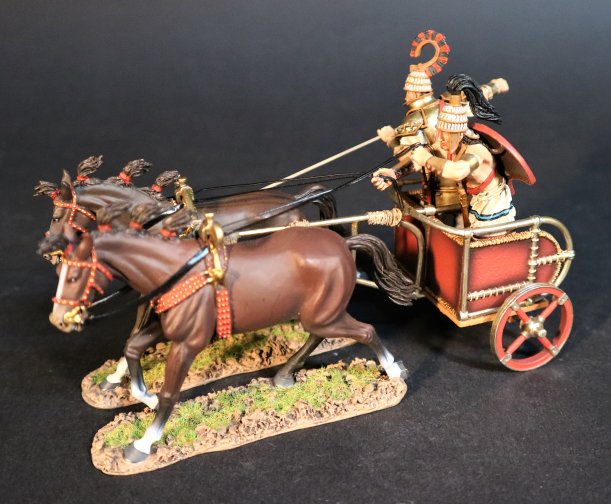
From what is known of chariot warfare it is unlikely that the chariots of this era were used in battle
en- masse.
It seems more probable that a chariot warrior, armed with a round shield and a short spear, would dismount to fight, with his chariot retiring a short way in order to await events.
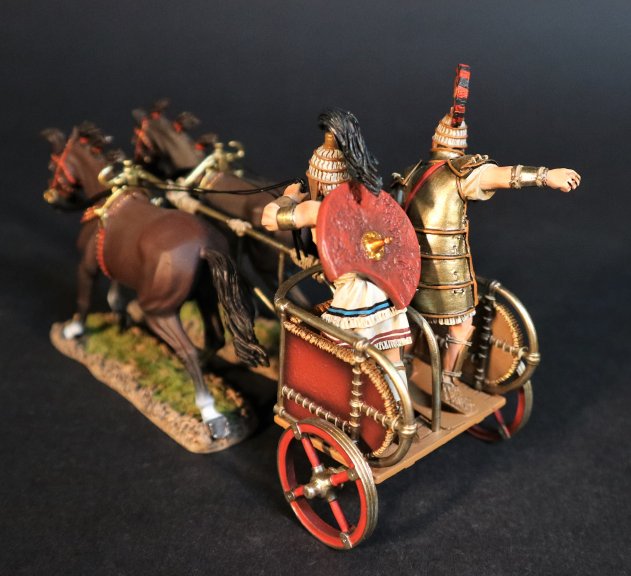
The traditional Mycenean chariot battle would see the chariots advance into contact with other chariots. The heavily armoured warrior would brace himself levelling his long spear for the inevitable clash with his opponent. As the lines of chariots inter-penetrated, the chariots would veer passed each other, an unlucky warrior having been knocked from his vehicle by a well aimed thrust.
The heavy Dendra Panopoly, a suit of armour made from 15 pieces of beaten sheet bronze, would have been worn by the Mycenean warrior.
In the Iliad Nestor delivers a pre-battle speech to the Greek chariotry. He instructs the charioteers to control their teams so they can charge in formation, the warriors to thrust with the spear from their chariot as “the men before your time sacked tower and city”.
Nestor is known for reminiscing about his youth, where he had fought battles and gained experience of tactics that were falling out of use.
This seemed a suitable opportunity to depict one of Nestor’s sons, in traditional armour, as his father would have previously worn.
PLEASE CONTACT YOUR LOCAL DEALER FOR FURTHER INFORMATION
THE TROJAN WAR
TROY
Laomedon, the legendary King of Troy, son of Ilus and Eurydice and father of Podarces (later famous as King Priam of Troy) brought about his own destruction and that of the initial city of Troy, by not keeping his word.
Laomedon refused to give the gods Apollo and Poseidon a promised reward for building the original walls of Troy. The gods sent a pestilence and a sea monster to ravage the land.
An oracle revealed to Laomedon that the only way to save Troy would be to sacrifice his daughter Hesione. She was bound to a rock to await her death by the sea monster.
The Greek hero Heracles who happened to be at Troy, offered to kill the sea monster and rescue Hesione in exchange for Laomedon’s divine horses, which had been a gift from the god Zeus to Tros, Laomedon’s grandfather.
Once Heracles had killed the monster and saved Hesione, Laomedon refused to give up the horses.
Heracles left Troy and then returned with a band of warriors, captured the city, and killed Laomedon and all his sons except for Priam, and Tithonus.

It was Priam who set about rebuilding the walls of Troy. Priam became a natural leader and had a deep understanding of trade and exchange. The location of Troy at the mouth of the Hellespont, the straits through which all sea traffic too and from the east were obliged by geography to pass. This afforded Troy tremendous opportunities for enrichment. The tolls and tariffs meant the city grew in greatness and wealth.
The towers and Priam’s new palace reached higher than the levels of the walls, and gleamed in the sun to tell the world that Troy, the jewel of the Aegean, was the greatest city in the world, ruled over by a mighty king and prospering under the protection of the gods.

TROY-02
THE TROJAN WAR,
TROY AND HER ALLIES,
THE SCAEAN GATEWAY.
(3 pcs)
model Size 7 ¼ ” x 2 ½ ” x 7 ”
(9 1/2” x 9” x 5” box size 1.32kg weight)

Large towers were usually built into the walls of Troy to defend a major gateway. The South tower was built to guard the Scaean Gate.
The Eastern wall was also reinforced by a large tower. This massive bastion at the north east corner of the city was built to defend a well which was the main water supply.


The city walls of Troy will be available over the next 4 months. The total width of all the Troy wall sets together, as seen in the above picture will be 32” and approximately 8” depth.
THE GREEKS
Traditionally, the Trojan War arose from a sequence of events beginning with a quarrel between the goddesses Hera, Athena and Aphrodite. Eris the goddess of discord, was not invited to the wedding of Peleus and Thetis, and so arrived bearing a gift. A golden apple, inscribed “for the fairest”.
Each of the goddesses claimed to be the “fairest”, and the rightful owner of the apple. They submitted the judgement to a shepherd they encountered tending his flock. Each of the goddesses promised the young man a boon in return for his favour. Power, wisdom, or love. The youth, in fact Paris, a Trojan prince who had been raised in the countryside, chose love, and awarded the apple to Aphrodite.
As his reward, Aphrodite caused Helen, the Queen of Sparta, and the most beautiful of all women, to fall in love with Paris.
The judgement of Paris earned him the ire of both Hera and Athena, and when Helen left her husband, Menelaus, the Spartan king, for Paris of Troy, Menelaus called upon all the kings and princes of Greece to wage war upon Troy.
Menelaus’ brother Agamemnon King of Mycenae, led an expedition of Achaean troops to Troy and besieged the city for ten years because of Paris’ insult. After the death of many heroes, including the Achaeans, Achilles, Ajax and the Trojans Hector and Paris, the city fell to the ruse of the Trojan Horse.
The Achaeans slaughtered the Trojans, except for some of the women and children whom they kept or sold as slaves. They desecrated the temples, thus earning the wrath of the gods.
Few of the Achaeans returned safely to their homes, and many founded colonies in distant shores.
The Romans later traced their origin to Aeneas, Aphrodite’s son and one of the Trojans, who was said to have led the surviving Trojans to modern day Italy.
ANTILOCHUS OF PYLOS
Antilochus was the son of king Nestor, and the brother of Thrasymedes.
He accompanied his father and his brother to the Trojan war. He was distinguished for his beauty, swiftness of foot, and skill as a charioteer.
Though he was among the youngest of the Greek princes, he commanded the Pylians in the war and performed many deeds of valour.
He was a favourite of the gods and a friend of Achilles, to whom he was commissioned to announce the death of Patroclus.
When his father Nestor was attacked by Memnon, Antilochus sacrificed himself to save him, thus fulfilling an oracle which had warned to “beware of an Ethiopian”.
Antilochus’ death was avenged by Achilles, who drove the Trojans back to the gates, where he is killed by Paris.
His ashes, along with those of Achilles and Patroclus, were enshrined in a mound on the promontory of Sigeion, where the inhabitants of Ilium offered sacrifice to the dead heroes.
Among the Trojans he killed were Melanippus, Ablerus, Atymnius, Phalces, Echepolos and Thoon. At the funeral games of Patroclus, Antilochus finished second in the chariot race and third in the foot race.

TWG-30
THE TROJAN WAR,
THE GREEKS,
GREEK CHARIOT,
ANTILOCHUS OF PYLOS.
(5 pcs)

From what is known of chariot warfare it is unlikely that the chariots of this era were used in battle
en- masse.
It seems more probable that a chariot warrior, armed with a round shield and a short spear, would dismount to fight, with his chariot retiring a short way in order to await events.

The traditional Mycenean chariot battle would see the chariots advance into contact with other chariots. The heavily armoured warrior would brace himself levelling his long spear for the inevitable clash with his opponent. As the lines of chariots inter-penetrated, the chariots would veer passed each other, an unlucky warrior having been knocked from his vehicle by a well aimed thrust.
The heavy Dendra Panopoly, a suit of armour made from 15 pieces of beaten sheet bronze, would have been worn by the Mycenean warrior.
In the Iliad Nestor delivers a pre-battle speech to the Greek chariotry. He instructs the charioteers to control their teams so they can charge in formation, the warriors to thrust with the spear from their chariot as “the men before your time sacked tower and city”.
Nestor is known for reminiscing about his youth, where he had fought battles and gained experience of tactics that were falling out of use.
This seemed a suitable opportunity to depict one of Nestor’s sons, in traditional armour, as his father would have previously worn.
PLEASE CONTACT YOUR LOCAL DEALER FOR FURTHER INFORMATION

